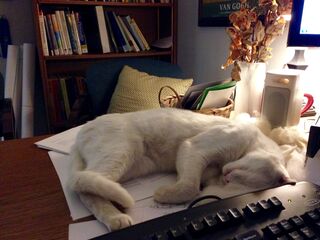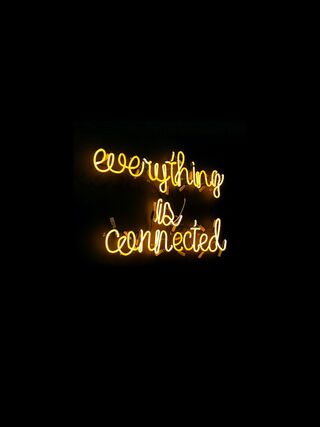Cognition
The Curious Case of the Professor Who Turned Into a Cat
How our natural sense of pattern recognition primes us for conspiracy theories.
Posted June 28, 2020

Buckle your seatbelts for the true(ish) tale of the professor who turned into a cat. “Impossible,” you say? Let’s look at the evidence.
At the college where I work, I had a colleague—a white-haired, blue-eyed organic chemist of 40 years’ tenure—called Dr. Jenkins. In the natural sciences building, the chemistry labs are housed in the windowless basement. Students report getting the creeps down there at night. They also report that there’s an even creepier sub-basement that few have seen, which has led many a student to speculate as to what sort of mad science happens down there. Considering that at a nearby university, two chemistry professors were recently busted for running a clandestine meth lab in the basement of their science building, the possibility of something secret going on perhaps isn’t as outlandish as it seems.
On my campus, there also lived a solid white, blue-eyed cat, creatively called Snowball. Snowball had adopted our campus and was beloved by mostly all—students, faculty, and staff alike. There were a few notable exceptions to her fan club: the campus physician and other members of the administration. No one could understand their objection to her, and many people, half out of affection for Snowball and half as an act of rebellion, let her into all sorts of places she wasn’t officially allowed, namely academic buildings and dorms. She could go just about anywhere she wanted, and she knew it.
But the question of why the administrators disliked Snowball lurked in the back of many people’s minds. Were they cat haters? No—several of them had cats at home. The campus physician cited health concerns, and a rumor that was purportedly started in the doctor’s office began to circulate that the cat had ringworm and was thus a danger to students. A faculty member took her to the vet, who concluded that she did not have any parasites. But the opposition from the powers that be remained, and one day… she disappeared.
Students began to note that of all the faculty who fawned over Snowball, Dr. Jenkins was never among them. Furthermore, they both bore white hair and blue eyes, and no one could recall having ever seen them in the same place at the same time. Even more suspiciously, she disappeared around the same time Dr. Jenkins retired. Dr. Jenkins had long been part of a group of faculty that had occasionally challenged the administration, and rumors abounded that he was on to something they didn’t want him to know. But how did he come across this information?
Students’ attention turned then to the basement of the natural sciences building. Dr. Jenkins, after all, was an organic chemist. In his secretive sub-basement lab, had he discovered the secret to transforming life into different forms? Becoming a cat would certainly give him access to places and conversations he wouldn’t otherwise have. And after all, cats have excellent hearing.
The evidence added up to one thing: Dr. Jenkins was Snowball. Snowball was Dr. Jenkins. And the campus administration knew. When Snowball disappeared from campus, students began to speculate that they were on to Dr. Jenkins’ unconventional science and had him and his cat doppelganger done away with.
Or so the story goes, according to a group of my students.
Every year in my Social Psychology class, I have my students make up a conspiracy theory and attempt to debunk it. I split the class in half, each half creates a detailed conspiracy theory, and the other half’s mission is to show that it’s not true. The professor who turned into a cat has always been one of my favorites because--not-so-secret confession time--I’m a crazy cat lady who was good friends with the real cat in the story. (As a side note, there is a real-life sub-conspiracy as to the circumstances of her disappearance and whether she was murdered. I’m happy to report that she is living the good life in her adoptive home!)
In the course, we talk about a concept called social cognition, which examines how our thought processes affect our social interactions and perceptions of others, and vice-versa. It is well-established in many subfields of psychology, including social cognition, that our brains are designed to pick up on patterns. This is a good thing, as we’d have a hard time surviving without a strong sense of pattern recognition. However, we’re so good at it that we often perceive connections between people, events, and details that only *seem* connected, but are actually not related.

In visual perception, we often look at ambiguous or amorphous scenes and “see” objects in them. Ever seen a “face” in a knotty pine wall or a cloud that looks exactly like Garfield? Unless your house is haunted, you know it’s probably not actually a face emerging out of your walls, but darn if it doesn’t creep you out anyway! That’s a phenomenon called pareidolia. The same thing happens with social perception: Our readiness to perceive patterns makes us “see” connections that aren’t really there, and those perceived connections can influence what we think about people and events.
One of the ways we incorrectly connect events is through a phenomenon called the illusory correlation, which is what I ask my students to exploit in their conspiracy theory assignments. In illusory correlation, we perceive two events as related because they share a detail or happen at the same time. In our minds, there is an “obvious” connection, even if the commonality between them is truly coincidental.
This is one of the things that make illusory correlations so hard to debunk. If conspiracy theories used completely made-up information, you could knock them down with a feather. Often, there really are similarities between two events; the part that’s incorrect is when we assume that they’re directly related, and that association can be difficult to unravel. In the story of Dr. Jenkins and the cat, every detail is verifiably true, other than the idea that Jenkins was the cat. It’s easy in this case to say that that part was false because we know science doesn’t work that way. But despite that, with this and every other conspiracy theory my students have generated, they have a difficult time definitively showing that these connections between events are false, even when they know the story isn’t true because their classmates made it up.

Our general tendency to recognize patterns, illusory or otherwise, also interacts with individual differences in illusory pattern perception. One recent study found that people who are more likely to believe they see patterns in random events and images like coin tosses or a Jackson Pollock painting were also more susceptible to believing in conspiracy theories. Interestingly, however, they found that reading about conspiracy theories made participants more likely to believe in other conspiracy theories and see “patterns” in other unrelated events. Another study found that having a high need for predictability and a low tolerance for uncertainty predicted more illusory pattern perception.
Ultimately, this particular facet of conspiracy theory proneness can be a useful ability, but in this case, it’s working on hyperdrive to undermine our thinking. How do we curtail it? That is another post for another day, but perhaps in the meantime, we can keep in mind that professors can’t turn into cats, and it’s a good idea to question our thinking and assumptions so we don’t end up believing that they can.




